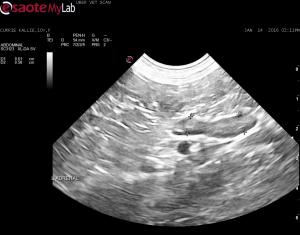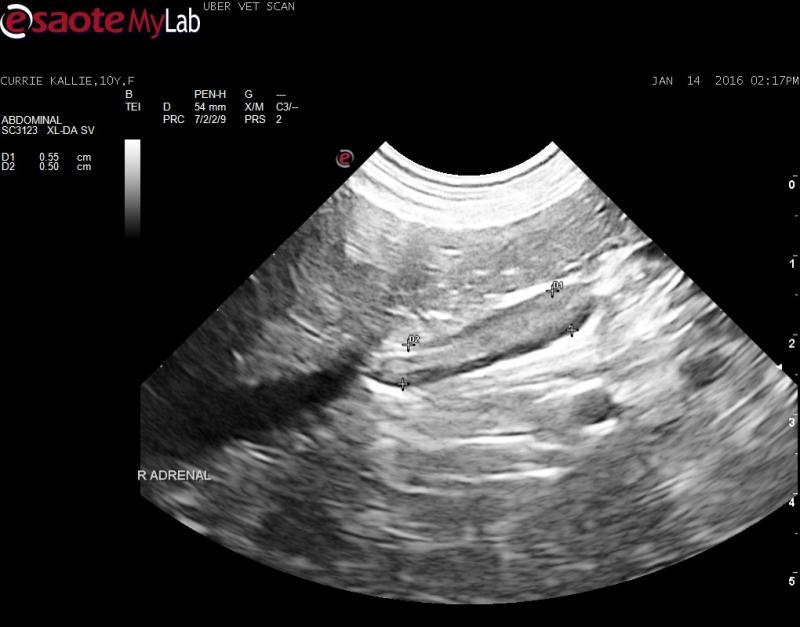– 10 yr old FS Collie Cross pu/pd, polyphagic, potbellied with ALP 1200, ALT mildly elevated; rDVM did not perform u/a yet
– O indicates that pet is more lethargic lately and yelps in pain
– GB shows an emerging mucocele pattern but mobile sludge also seen in some parts
– adrenals “plump” although measurments at cranial and caudal poles wnl
– I don’t think I see surrounding inflammation or anything that indicates imminent perforation BUT positive Murphy when scanning the GB
– 10 yr old FS Collie Cross pu/pd, polyphagic, potbellied with ALP 1200, ALT mildly elevated; rDVM did not perform u/a yet
– O indicates that pet is more lethargic lately and yelps in pain
– GB shows an emerging mucocele pattern but mobile sludge also seen in some parts
– adrenals “plump” although measurments at cranial and caudal poles wnl
– I don’t think I see surrounding inflammation or anything that indicates imminent perforation BUT positive Murphy when scanning the GB
So is medical management with ultrasound monitoring acceptable for this one?
A LDDST is scheduled. If PDH, will treatment help with the mucocele?


Comments
Shelities are number 1 in
Shelities are number 1 in mucoceles and TCC in my book… This one is not too overdistended but merits a Gb motility study and surely some actigal and likely sx… if its my dog out goes th eGB because vague signs and rising SAP and mucocele means its th eGb til IO can prove otherwise in a sheltie for sure.
True PUPD??? USG < 1.020 in multiple samples?? then yes lddst but why not screen first with Urine cortisol/Creatineine ratio? Its cheap and have to run the urine anyway…. if UCCR is negative then no cushings… if + then go forward.
Also always check a BP in Cushings suspects and roughly 50% are hypertensive so its another + predictive factor.
Mucoceles go with Cushings that’s for sure and suppoorted by 2 mucocele articles.
Here’s a little bullet I wrote up a while ago that may be applicable to your question on cushings:
Notes regarding Cushing’s Clinical Presentations:
Nearly all Cushings dogs have SAP elevations and true PU/PD (USG < 1.025) and most are polyphagic.
Cushings dogs are > 6 years and usually > 9 years old, usually have poor skin coats, body scores > 3/5, and are usually sedentary animals.
Its important to remember that Cushings dogs usually look and play the part and other diseases cause false + stress related cortisol spikes. On rare occasion a Cushings dog will not follow the rules but this is truly an exception. Potential Cushings patient workups can be costly and frustrating if not definitive and, in my experience, the non definitive patient usually has something else going on that may be contributing to some of the clinical signs a cushings dog will have, especially SAP elevations or PU/PD. Based on this prelude of information I came up with the following algorithm in the spirit of diagnostic efficiency.
The following suggested protocol is based on current available literature on Cushings disease and extensive clinical- sonographic experience evaluation + Cushings and False + LDDST & ACTH stim. cases in order to maximize the efficiency of a Cushing’s workup in practice.
Screen first, workup second
1) UA: Repeatable (2-3 urine samples) Urine specific gravity & urine cortisol/creatinine ratio (UCCR): If repeatable
USG< 10.20 and + UCCR move to next step 2.
Note: UA is inexpensive and easy to obtain and if UA criteria is not met for Cushings then resources can be spent into
other more pertinent diagnostics or left on hold until the UA criteria is met in emerging Cushings cases.
2) Sonogram: Does the patient have concurrent disease clinically or sonographically as non-Cushings illness will influence the potential false + LDDST or even ACTH stim. The sonogram gives a global perspective of the internal health of the patient to be considered in the Cushings workup as an assessment of concurrent disease. Is there a concurrent neoplastic process, UTI pancreatitis, mucocele….? Are the adrenals enlarged (Cushings-PDH, stress, age related or breed variant), or atrophied (Iatrogenic Cushings or adrenal burnout), have asymmetric enlargement
( Adrenal tumor, hyperplasia, adenoma, age related variant), or is there vascular invasion (Invasive pheo with false + UA criteria or adenocarcinoma or phrenic thrombosis)? The sonogram answers these questions proactively.
3) LDDST (0.01 D-Sodium phosphate mg/kg IV) (Better screening test but plagued with false +) Use if there is potential early Cushings or if adrenal asymmetry present on sonogram suspecting tumor. Use LDDST in cats at a higher dose (0.1 mg/kg IV).
OR
4) ACTH stim. (Better confirming test but can have false +) Use if the patient “looks” Cushingoid or if bilateral adrenal
enlargement is present, or high normal width on sonogram, or if iatrogenic Cushings suspected (Cortisone tx in past). 5) If diabetic then run both LDDST & ACTH stim.
5) Run a serial blood pressure in a BP friendly non “white coat effect” atmosphere. Run at least 3 at different times over a few hours or when eating as the patient tends to be calm when eating or give Torbutrol when entering the facility.
6) Perform CT of the pituitary to identify macroadenoma expansion if any lethargy or dullness or other central clinical CNS signs are minimally present.
Suggested reading:
Behrend EN, Kooistra HS, Nelson R, et al. Diagnosis of Spontaneous Canine Hyperadrenocorticism: 2012 ACVIM Consensus Statement (Small Animal). J Vet Intern Med 2013;27:1292–1304 .
Thanks EL – what makes this
Thanks EL – what makes this case difficult is complex disease and a cranky owner with no funds. I feel bad for the rDVM that is trying his best to help. I like the idea of running the UCCR first.
A “cranky” owner with no
A “cranky” owner with no money would not be able to afford the cushings treatment OR consider removal of the mucocoele. Unfortunately, some of my most miserable clients are the ones that just don’t have the funds to treat their pets. A very small percentage make our lives miserable.
Get a UA and if the SG is concentrated that will probably eliminate CCD (especially if on multiple samples). I ususally get the very first sample of the morning (most concentrated). If not you could do a LDDS test. I run it in house and it is relatively inexpensive using the IDEXX SNAP test. The problem with the urine test is that if it is positive you still have to run other tests.
I hear ya Randy! We can only
I hear ya Randy! We can only do, what we can do and write really good records to document everything!
LDDST was strongly suggestive
LDDST was strongly suggestive for PDH on this one FYI